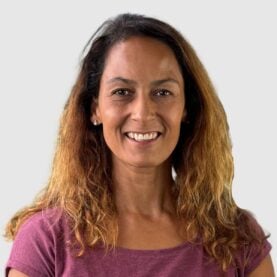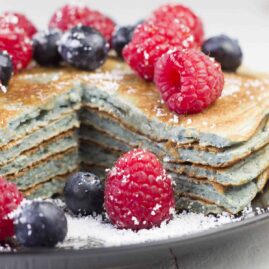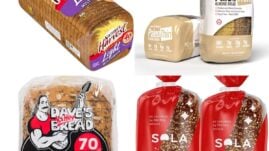Oatmeal is often hailed as a great breakfast option, and you might have been told that oatmeal is especially good for people living with diabetes.
But is that really true? Is oatmeal a good choice when it comes to diabetes management, or will it wreak havoc on your blood sugars?
In this article, we’ll have a look at why oatmeal is often recommended for people living with diabetes, how it generally impacts blood sugars (including the science behind it), and what type of oats, if any, you should add to your daily routine.

Table of Contents
- What are the health benefits of oats?
- What does the science say about oats and diabetes?
- Is oatmeal a carbohydrate?
- Which oatmeal is best for people living with diabetes?
- How oatmeal impacts your blood sugar
- How to manage blood sugars if you eat oatmeal
- Final thoughts: Should you eat oatmeal if you live with diabetes?
What are the health benefits of oats?
Oatmeal is made of oats, rolled or steel-cut, cooked in a warm liquid such as water or milk. A hot bowl of oatmeal can be like a warm hug, and most people love it for its flavor, nutritional value, and health benefits.
Oats are rich in nutrients such as dietary fibers (both soluble and insoluble), phosphorus, thiamine, magnesium, and zinc.
The soluble fiber, known for its gelling effect, helps lower LDL (“bad”) cholesterol levels and reduce the risk of heart disease by slowing digestion and the absorption of cholesterol into the bloodstream. This gelling property also contributes to the ability of oats to manage hunger and help with weight management by prolonging feelings of fullness after eating.
Soluble fiber also slows the absorption of sugar from the digestive tract, preventing spikes in blood sugar and insulin after meals.
Insoluble fiber, meanwhile, helps with digestive health by adding bulk to stool.
(If you are not used to consuming high amounts of fiber, be sure to introduce this food slowly and drink plenty of water to prevent constipation.)
What does the science say about oats and diabetes?
The science is all in favor of people living with type 2 diabetes or prediabetes eating oatmeal. However, there is very little research available when it comes to type 1 diabetes and oatmeal.
A large study following 75,000 adults for 14 years found that eating soluble fiber, such as is found in oats, may help lower blood sugars and potentially reduce the risk of developing diabetes.
A 2020 review of eight studies that included about 470,000 participants explored the effects of oats on diabetes management, revealing significant benefits. It found that regular oat consumption could not only lower after-meal blood sugar spikes but also potentially reduce insulin needs for those with type 2 diabetes.
Beyond immediate glucose control, the research further suggests that oats might lower the risk of developing type 2 diabetes and even reduce all-cause mortality rates, highlighting the value of oats in a balanced diet for diabetes and overall health.
Although the studies currently available are very promising, the researchers continue recommending clinical trials to confirm the benefits of oats.
Is oatmeal a carbohydrate?
One of the main reasons why it can be a little hard to wrap your head around whether oatmeal is good for people living with diabetes is that it’s a carbohydrate (“carb”), and many people living with diabetes manage their carbohydrate intake tightly to keep blood sugars in a healthy range.
Carbohydrates are the main nutrient that is converted into glucose, leading to immediate changes in blood sugar levels. (While proteins and fats can also influence blood glucose, their effects are generally slower and less direct compared to carbohydrates.)
Often when we think of carbs, we think of bread, candy, and soda, but in reality, most foods contain carbs and will impact blood sugars to some degree.
And the same thing applies to oats. While oats contain very limited natural sugars, they are primarily made of carbohydrates and so will impact blood sugars to some extent.
Which oatmeal is best for people living with diabetes?
Oatmeal can be made of different types of oats, and when it comes to blood sugar management, they are not all created equal.
Generally, the type of oats you want to choose for your oatmeal should be the least processed and have a relatively low glycemic index (GI).
The glycemic index of a food tells you how quickly it affects blood glucose levels. If you live with diabetes and are looking for fewer blood glucose spikes, you will ideally want to choose foods with a lower GI.
Pure glucose (sugar) has a GI of 100. Oatmeal made with rolled oats or steel-cut oats has a GI of 48 to 53, while oatmeal made from more processed oats such as instant oats has a GI of 76.
Steel-cut oats
This is the least processed type of oats, which means that it retains all the fiber and other nutrients that make oatmeal so healthy.
It is composed simply of oat groats that have been cut in half. This type of oats is higher in fiber than any of the other types of oats, which makes them ideal from a blood sugar perspective.
Note that it can be a little more time-consuming to cook with steel-cut oats, and they do give your oatmeal a slightly different texture and flavor than other types of oats: Generally, the cooking time for steel-cut based oatmeal is 20 to 30 minutes and the result is a chewy porridge.
1 serving (1/4 cup, dry) of steel-cut oats contains:
- Calories: 150
- Protein: 5 grams
- Fat: 2.5 grams
- Carbohydrates: 27 grams
- Fiber: 4 grams
Rolled oats (old-fashioned oats)
These oat groats have been steamed and flattened, which makes them easy to cook but also reduces the fiber and vitamin content slightly. They are still good from a blood sugar perspective, but some people will see more of a blood sugar increase than with steel-cut oats.
Since they have been processed, it only takes 2 to 5 minutes to cook oatmeal with rolled oats. You can also use rolled oats in a variety of other dishes as a replacement for flour.
1 serving (1/2 cup, dry) of rolled oats contains:
- Calories: 150
- Protein: 5 grams
- Fat: 3 grams
- Carbohydrates: 27 grams
- Fiber: 4 grams
Instant oats or quick oats
These oats are rolled oats that have gone through further processing. Plain versions have roughly the same nutritional value as rolled oats but a higher glycemic index.
From a blood sugar perspective, this means that quick oats will have the most dramatic effect on your blood sugar of the three oat types.
It’s also important to be aware that packets of instant oats often include other ingredients, such as sugar and fruit, so it’s important to read the nutrition label.
1 serving (1 packet, dry) of plain instant oats contains:
- Calories: 120
- Protein: 4 grams
- Fat: 2 grams
- Carbohydrates: 21 grams
- Fiber: 3 grams
How oatmeal impacts your blood sugar
Whether or not oatmeal will spike your blood sugar depends on which type of oats you choose and how your body reacts to oatmeal.
We’re all different, and how we react to eating certain types of food can vary from person to person. This is why it’s important that you use a glucose meter or continuous glucose monitor (CGM) to measure your blood sugar after eating to learn how you react to different types of food.
Read When Should You Check Your Blood Sugar to learn more about when and how often to check.
Registered dietitian and certified diabetes care & education specialist Ariel Warren suggests that you aim for your blood sugars to be below 140 mg/dL (7.8 mmol/L) 1 to 2 hours after finishing a meal.
If you need a slightly looser target, aim for less than 180 mg/dL (10 mmol/L) 1 to 2 hours after eating. (Check with your healthcare provider to ensure that these targets are safe and appropriate for you.)
If you see that your blood sugar is higher than 140 to 180 mg/dL (7.8 to 10 mmol/L) 1 to 2 hours after finishing your oatmeal, this food might not be a good option for you, or you might want to experiment with smaller portion sizes or a different amount of insulin, if that’s how you manage your diabetes.
Avoiding added sweeteners like maple syrup and consuming your oatmeal along with a healthy fat or protein, such as nut butter, eggs, or Greek yogurt, can help keep blood sugar levels more stable.
Certain conditions, such as gastroparesis (a condition in which stomach emptying is delayed), can also make it a bit more challenging to enjoy high-fiber foods such as oatmeal.
Although oatmeal generally is considered a good type of food for people living with diabetes, you have to consider your other conditions and overall health.
How to manage blood sugars if you eat oatmeal
Regardless of what type of diabetes you live with or how you manage your blood sugars, you need to establish how oatmeal impacts your blood sugars and then adapt from there to optimize your blood sugar management.
Non-insulin-dependent diabetes
If you don’t manage your diabetes with insulin but instead rely on diet and exercise, metformin, and/or other oral or injectable diabetes medications, you have limited tools to lower your blood sugar levels after you eat.
If you observe that your blood sugar is higher than 140 to 180 mg/dL (7.8 to 10 mmol/L) 1 to 2 hours after enjoying your oatmeal, you can try having smaller portions or going for a walk after your meal. Even a short walk can be an excellent way of reducing blood sugars.
If you find that your blood sugars spike and stay high after consuming oatmeal regardless of what you do, you might want to reconsider if oatmeal should be your everyday breakfast choice.
Insulin-dependent diabetes
If you manage your diabetes with insulin, you should first focus on calculating the right dose of insulin for the meal. You’ll also need to think about the timing of your insulin and how quickly what you eat gets converted into glucose in the bloodstream.
When it comes to calculating your insulin dose, carb counting is considered the gold standard for successful blood sugar management.
Learning how to carb count might be slightly intimidating at first, but if you need a bit of support your endocrinologist should be able to refer you to a certified diabetes care & education specialist (CDCES).
Final thoughts: Should you eat oatmeal if you live with diabetes?
Just as there is no such thing as a single best “diabetes diet,” there is not one food that works well for everyone, and that also applies to oatmeal.
Oatmeal has a lot of great health benefits, and studies have shown that oatmeal can be beneficial for people living with prediabetes as well as type 2 diabetes.
But ultimately we’re all different, and how your blood sugars react to eating oatmeal might be different from how my blood sugars react, so it’s important that you learn what works for you.
That means measuring your blood sugar levels before and after you enjoy your oatmeal to gain an understanding of how it affects your blood sugar.
Once you’ve done that a few times, you can make an informed decision on whether oatmeal is the right choice for your daily breakfast or just something to be enjoyed occasionally.
And if you have any questions or concerns, be sure to check in with your diabetes care team.









Michael
Oatmeal is really bad for me since I have type 1 diabetes for 56 years. Oatmeal always spike up my BS..I eat a small bowl of Cheerios/All Bran Buds with cinnamon/ginger/turmeric powder, 1 tablespoon of extra virgin oil, one teaspoon of unsweetened cocoa powder, one tablespoon of Two Good yogurt, one tablespoon of Atkins Creamy Vahilla and one egg. I blend them for 30 secs together without Cheerios. It does not spike up my BS quickly but it does spike little bit up slowly. I do HIIT for 10 minutes after eating Cheerios. My BS goes low quickly so I drink 1-2 ounces of apple juice plus chips or crackers. I understand people with type 1 diabetes are different indivdually.
Len Jones
I hear you! There’s so much conflicting info out there. I don’t know why the “experts” can’t all agree as to whether a certain food is or isn’t good for you.
Chris
I have a CGM and I can tell you without exception that oatmeal causes an unacceptable spike in blood glucose. Adding peanut butter to it spreads it out but it still stays high. I don’t know which is worse, a spike that goes up and down or one that stays high.
Bruce
You list steeled oats as 1/4 cup for serving…and the nutritional values.
Then you list rolled oats as 1/2 cup per serving…and the nutritional values.
Would it not be better to list them both as either 1/4 cup OR 1/2 cup to better compare the nutritional numbers.
Or am I missing something…?
Christel Oerum
A serving of steel cut oats is commonly listed as 1/4 cup. It might seem more logical to compare 1/2 cup to 1/2 cup but according to the FDA: “By law, serving sizes must be based on the amount of food people typically consume”
Minhaj
I am using rolled oats with milk and one boiled egg in breakfast but there is always a spike in blood sugar after two hours, any one can suggest me how do I fix it. I have only one kidney. will appreciate.
Christel Oerum
I would suggest discussing insulin dosing timing with your doctor. Most rapid-acting insulin will peak about 1-1.5 hours after injected so you’ll want to try and match that with the food impact
Bob
I eat old fashion oats, with fruit, walnuts, and cinnamon,with milk at least 3-4 times a week, My sugar is under control, I feel great, and full. Just my 2 cents. It is my favorite breakfast for most of my 1st year of dealing with pre diabetes.
Bob
Good information, I like to eat oatmeal, and my wife and I debate over its benefits and harm for those of us living with type 2. I will test my blood sugars 1-2 hours after breakfast, thanks!
Einez Crespo
Oh for chrissakes on rolled oats! I’m trying to lower my blood sugar and now I’m told this? Great.
KUNAL
good informartion